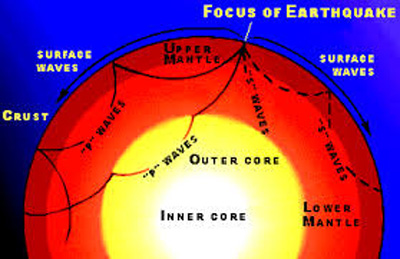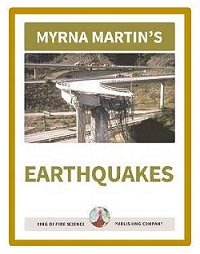Focus & Epicenter of an earthquake
Origin of an earthquake
Where is the earthquake focus? The focus of an earthquake is the point where the rocks start to fracture. It is the origin of the earthquake.
The epicenter is the point on land directly above the focus.

Focus of an Earthquake, USGS
HYPOCENTER of an earthquake
The focus is also called the hypocenter of an earthquake. The vibrating waves travel away from the focus of the earthquake in all directions. The waves can be so powerful they will reach all parts of the Earth and cause it to vibrate like a turning fork.
Epicenter of an earthquake
Directly above the focus on the Earth's surface is the earthquake epicenter. Earthquake waves start at the focus and travel outward in all directions. Earthquake waves DO NOT originate at the epicenter.
News stories about earthquakes
Most news stories on earthquakes will list the epicenter of an earthquake and then tell how deep the earthquake was from the epicenter. Great earthquakes that occur in subduction zones may give an earthquake focus but they actually break along hundreds of kilometers. The 1960 Chilean earthquake broke along 800 kilometers of the fault line.


Click for More Information and to Order
Shallow-focus earthquakes
Richter scale used for shallow-focus earthquakes
Shallow-focus earthquakes occur between 0 and 40 miles deep. Shallow-focus earthquakes are much more common than deep-focus earthquakes. Crustal plates moving against each other produce most of the shallow-focus earthquakes here on Earth. These earthquakes are generally smaller and scientists use the Richter scale when measuring these earthquakes.
Energy released by shallow focus earthquakes
Shallow-focus earthquakes are much more dangerous than deep-focus earthquakes. They release 75% of all the energy produced by earthquakes each year. They are crustal earthquakes that are smaller than deep-focus earthquakes.
Deep-focus earthquakes use moment magnitude scale
Deep-focus earthquakes occur 180 miles or more below the Earth's surface. These earthquakes occur in island arc or deep ocean trenches where one plate is slipping over another in subduction zones. Great earthquakes where one plate is slipping over another plate in a subduction zone trigger deep-focus earthquakes. They are the largest earthquakes and scientists use the moment magnitude scale to measure them.
KIDS FUN Science Bookstore
Check out Myrna Martin's award winning textbooks, e-books, videos and rock sets. The Kids Fun Science Bookstore covers a wide range of earth science topics. Click here to browse.










